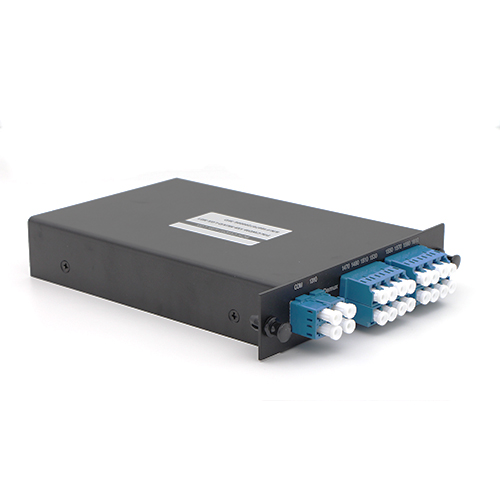In CWDM networks, bidirectional CWDM MUX DEMUX (also called dual fiber CWDM MUX DEMUX) uses the same wavelengths for transmitting and receiving. It is often used in dual way transmission applications. The working principle is easy to understand. A duplex fiber cable links two dual-fiber CWDM MUX DEMUXs supporting the same wavelengths installed on each end of the fiber optic network. The wavelengths of the two fibers are the same, but they are running on the different directions for duplex transmission. However, in some cases, there is only one fiber available for network capacity expansion. Then, single fiber CWDM MUX and DEMUX is being used, which is very different from the dual-fiber one.
The single fiber CWDM MUX DEMUX has a simplex line port (shown in the above picture), which is the biggest difference from the bidirectional CWDM MUX DEMUX on the appearance. There are also some single fiber CWDM MUX and DEMUX are made with a duplex port. But only one port of this duplex port is in use, the other is usually marked with N/A. For instance, our FMU single fiber CWDM MUX DEMUX also uses this design.
The reason why single fiber CWDM MUX and DEMUX can achieve dual way transmission is because it uses the CWDM wavelengths in a different way compared with the bidirectional CWDM MUX DEMUX. In bidirectional CWDM network, each wavelength runs on two opposite directions. However, in single fiber CWDM network, each wavelength just runs on one direction. In other works, if you want to build a dual way transmission link between two sites, you can use one wavelength over duplex fiber with dual-fiber CWDM MUX DEMUX, or use two wavelengths (one for TX and the other for RX) over simplex fiber with single fiber CWDM MUX DEMUX.The above picture shows how CWDM wavelengths are used in a single fiber CWDM network. In this network, 16 wavelengths are used to support 8 pairs of dual-way transmission. On site A, there deployed an 8-channel single fiber CWDM MUX DEMUX using 8 wavelengths for transmitting and the other 8 wavelengths for received. On the opposite site B, also a single fiber CWDM MUX and DEMUX is deployed. However, the wavelengths for TX and RX are reversed. For instance, a pair of dual-way signal uses 1270nm for TX and 1290nm for RX on site A, while use 1290nm for TX and 1270nm for RX on site B. This is how the single-fiber CWDM MUX and DEMUX achieving dual-way transmission.





